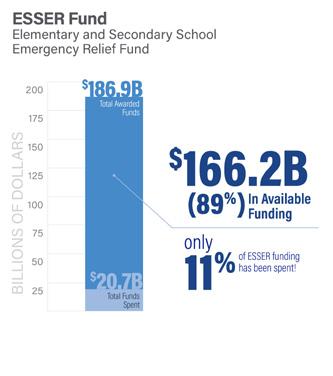
3 minute read
Impact on Education Funding and AV
ARP ACTBASICS
IMPACT ON EDUCATION FUNDING AND AV
The Coronavirus Aid, Relief, and Economic Security (CARES) Act has gone a long way in improving the quality of life for many Americans. But the government assistance extends beyond helping people like you and me, it’s also being used to help the education sector navigate this difficult time. The CARES Act has been augmented by the Coronavirus Response and Relief Supplemental Appropriations Act (CRRSA Act) and the American Rescue Plan Act (ARP Act). All these appropriations are handled through the U.S. Department of Education’s Education Stabilization Fund (ESF).
Combined, they have earmarked over $269 billion to states for K-12 through Higher Ed uses. That’s billion with a B.
Like many government programs, there are rules for specific uses, and it can be difficult to understand what exactly any of it means. Which facilities have received funds? Do these funds have to be used in a certain way? What role does AV equipment have for facilities receiving funds from the ESF? Continue reading as we examine what the ESF means for the education sector.
ENROLLMENT FORMULA FUNDS
Enrollment Formula Funds make up half of the overall funding – meaning funds are divided based on enrollment population of the school (ie. larger student population gets more money). Half of these funds were allocated to provide grants to struggling students. The other half can be used at the institution’s discretion, with many choosing to expand their remote learning programs, build their IT capacity to support such programs, and train faculty and staff to operate effectively in a remote learning environment. It’s important to note that funds in this case are NOT just allocated to state schools, private institutions and specialty schools also across the country also received sizeable support.
GOVERNOR’S EMERGENCY EDUCATION RELIEF FUND
The Governor’s Emergency Education Relief Fund (GEER) provides funds directly to governors to serve education facilities within their state at their discretion.
The GEER is one of the primary ways K-12 education facilities can receive funds from the ESF. Governors can disperse these funds to a wide variety of educational institutions, including public and private schools. Like Enrollment Formula Funds, this resource can be used to expand distance learning capabilities for educational facilities. In fact, in many ways there is a larger gap to fill in getting K-12 facilities equipped for remote learning. While colleges and universities have been introducing online learning components and programs for years, it was a far less common concept for both teachers and students in the K-12 environment.
In all, the GEER provides $4.2 billion to state governors; a breakdown of funding by state can be found here.
ESSER & HEER FUNDS OVERVIEW
AVAILABLE VS. SPENT
CHECK OUT THIS ARTICLE ONLINE ADDITIONAL MINORITY SERVING INSTITUTION FUNDING
In addition to Enrollment Formula Funds, $4.85 billion has been set aside for minority-serving institutions currently receiving Title III, V, or VII funding. This includes Historically Black Colleges and Universities (HBCUs) and Tribally Controlled Colleges and Universities (TCCUs), as well as institutions serving low-income students. Unlike the Enrollment Formula Funds, institutions receiving these funds do not have to earmark half for grant use, granting these institutions flexibility in how they spend their funds.
The ESF is equipping educational institutions with funding, and we can fully expect they will be looking to AV integrators to help provide the flexibility they need in each and every room going forward. Keeping students connected with teachers and each other through technology is what we do every day.












